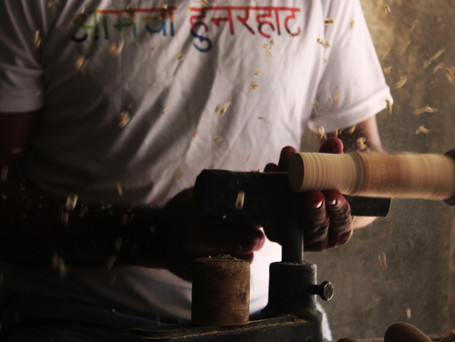
TOY-MAKING IN CHANNAPATNA
In the 1700, upon receiving a gift from Persia, Tipu Sultan invited Persian artisans to his kingdom to train local craftspeople in the art of lacquered wooden toys. Over the last few centuries, the craftspeople in Channapatna, have continued to adopt and adapt lacquerware skills and techniques from far-flung empires.
Towards the end of the 20th century, workers and their livelihoods suffered at the hands of toxins from poor quality raw materials. Interventions from the government and NGOs have since helped reintegrate safe tools and natural, vegetable dyes into the production system.
Today, the work of the Channapatna toy-makers boasts Geographical Indication (GI) status under the World Trade Organization. This label demonstrates the recognition of human talent and skill, the use of natural and environmentally friendly raw materials and techniques that are indigenous to the region.
We travelled three times this year to the small town of Channapatna on the road connecting Bangalore and Mysore, from where we source many of our embellishments. A local businessman, Mr Sayyed, and his fellow craftsman, Mr Imran, were kind enough to give us a demonstration on the lacquer production and toy making process. We thank them for giving us a better understanding of the historical and present-day significance of this age-old craft!




Channapatna toys are lacquered with a mix of powdered vegetable dyes and resin. Small quantities of resin are heated, melted, and softened over a fire. Residual colour on the stick blends into the molten resin, and adds a little shade to the new mix right the start. The lightly shaded resin is stretched and swirled around using two sticks, in order to blend the colours in more evenly.
Like a sticky daandiya raas!


The shades change subtly, and drastically, and within seconds!




Small pinches of dye are added gradually, at intervals. This makes it easier to observe the shade and add more colour only if and as needed. The melted resin clings to the sticks, and is highly elastic, which helps to colour the lacquer and maintain consistency.
Once the shade is satisfactory, it's scraped off the sticks onto a wetted metal plate (lacquer is water-resistant and will not stick to a wetted plate). The lump of lacquer is then stretched out by hand, and rolled into a long stick, which hardens as it dries. When it's solid, the stick is broken into smaller, more manageable pieces, ready to use to dye the toys.


AND ON TO THE TOY MACHINE!
A cylindrical (or sometimes square) piece of wood (called 'doodhi' wood in the vernacular) is firmly hammered into the machine, and set spinning. The small log is then shaved to the required diameter, and then carefully shaped into whatever object is being carved.
This is the reason that all Channapatna toys are rounded/cylindrical, and symmetrical for this reason. More complex designs are created by joining multiple such pieces together.




Once the correct dimensions and smoothness have been achieved, it's time to colour the wood! The lacquer stick is gently pressed into the wood, which continues to spin. The spinning motion generates friction, which heats and melts the lacquer, and transmits the colour onto the wood. A dried leaf is used to then smoothen and even out the dye, almost acting as a polish.


WE MADE A BUTTON!
This is the Channapatna process in a nutshell. The men and women of Channapatna have been practicing this craft for generations. Most of them have learned this initially by observing their parents and practicing and developing their skill as they get older.
The workshops are attached to the homes of the craftspeople, in a small village. setting. These workshops can accommodate 2-10 people, from our observation. The photos below were taken on a dinky Kodak KB10 camera, in keeping with the toy theme!
Fun fact: Toy making is a messy affair; there is sawdust everywhere! In case you were wondering (we sure did) about the waste generated by the craft, all the waste-wood we see is used in the production of incense sticks!
